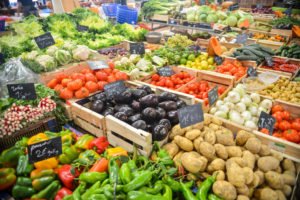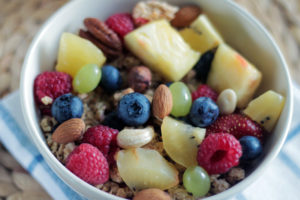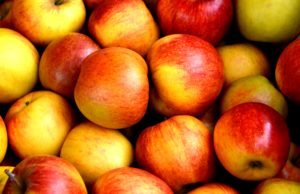When at the grocery store the fresh fruit and vegetables look inviting and tasty. But wait, looks can be deceiving.
Do you realize that frozen fruits and vegetables are actually in many cases healthier and cheaper? Especially if you are buying them out of season?
Fruits and vegetables destined to be shipped to the fresh-produce aisles around the country typically are picked before they are ripe, which gives them less time to develop a full spectrum of vitamins and minerals. Outward signs of ripening may still occur, but these vegetables will never have the same nutritive value as if they had been allowed to fully ripen on the vine. In addition, during the long haul from farm to fork, fresh fruits and vegetables are exposed to lots of heat and light, which degrade some nutrients, especially delicate vitamins like C and the B vitamin thiamin.
While the first step of freezing vegetables—blanching them in hot water or steam to kill bacteria and arrest the action of food-degrading enzymes—causes some water-soluble nutrients like vitamin C and the B vitamins to break down or leach out, the subsequent flash-freeze locks the vegetables in a relatively nutrient-rich state.
When vegetables are in-season, buy them fresh and ripe. “Off-season,” frozen vegetables will give you a high concentration of nutrients. Choose packages marked with a USDA “U.S. Fancy” shield, which designates produce of the best size, shape and color; vegetables of this standard also tend to be more nutrient-rich than the lower grades “U.S. No. 1” or “U.S. No. 2.” Eat them soon after purchase: over many months, nutrients in frozen vegetables do inevitably degrade. Finally, steam or microwave rather than boil your produce to minimize the loss of water-soluble vitamins.
Fruits are full of antioxidants essential for good health, especially berries!!
Summer is here and berries are the crown jewels of summer! The wonderful gems that inspire pies, ice cream treats, cobblers, parfaits, and whipped cream wonders. Best of all, berries deliver super-healthy antioxidants that help you fight disease! Did you know that one cup of berries provides all the disease-fighting antioxidants you need in a single day! Raspberries, blueberries, strawberries, and blackberries are plentiful in most corners of the U.S. In fact berries are available almost year-round now…and even though they may be more expensive some times of the year, they’re still much more accessible than they used to be. Also mildly steaming blueberries, they say that the antioxidant level is enhanced, making more antioxidants available to the body. Hedge your bets by eating as many antioxidant-rich foods as possible, since researchers don’t yet fully understand the complexities involved with bioavailability. It’s also why you should shoot for foods that offer the highest antioxidants, such as the top producers like berries. On the color wheel, the purple-blue-red-orange spectrum is home to the most antioxidant-rich fruits. Wild blueberries are the winner overall. Just one cup has 13,427 total antioxidants – vitamins A & C, plus flavonoids (a type of antioxidant) like querticin and anthocyanidin. That’s about 10 times the USDA’s recommendation, in just one cup! Cultivated blueberries have 9,019 per cup and are equally vitamin-rich. Buying tip: Peak season starts in mid-May, so blueberries are less expensive during the summer.
Did you know that one cup of berries provides all the disease-fighting antioxidants you need in a single day! Raspberries, blueberries, strawberries, and blackberries are plentiful in most corners of the U.S. In fact berries are available almost year-round now…and even though they may be more expensive some times of the year, they’re still much more accessible than they used to be. Also mildly steaming blueberries, they say that the antioxidant level is enhanced, making more antioxidants available to the body. Hedge your bets by eating as many antioxidant-rich foods as possible, since researchers don’t yet fully understand the complexities involved with bioavailability. It’s also why you should shoot for foods that offer the highest antioxidants, such as the top producers like berries. On the color wheel, the purple-blue-red-orange spectrum is home to the most antioxidant-rich fruits. Wild blueberries are the winner overall. Just one cup has 13,427 total antioxidants – vitamins A & C, plus flavonoids (a type of antioxidant) like querticin and anthocyanidin. That’s about 10 times the USDA’s recommendation, in just one cup! Cultivated blueberries have 9,019 per cup and are equally vitamin-rich. Buying tip: Peak season starts in mid-May, so blueberries are less expensive during the summer.
Cranberries are the tart crown jewels of turkey feasts. They’re also antioxidant powerhouses (8,983). To get cranberries after the holiday scene has passed, creative cooks sneak dried cranberries into risottos, salads, salsas, and trail mixes.
All-American apples are also vitamin- and antioxidant-rich treats. The classic Red Delicious (5,900), Granny Smith (5,381), Gala (3,903), and many other varieties are available nearly year-round. Applesauce, juice, and jellies are also tasty apple sources, but beware of added sugar (check the label). Here’s a tip: Mix some chopped apple into a tuna  salad for a sandwich.Finally, orange-colored fruits are good sources of antioxidants as well. One naval orange has 2,540; the juice has about half that. Bite into a luscious ripe mango, and you’ll get 1,653. A peach has 1,826, tangerines, 1,361, and pineapple, 1,229. Dried versions of these fruits are smaller, but they still have plenty of antioxidants. For instance, just half a cup of these dried fruits packs quite a punch: prunes (7,291), dates (3,4 67), figs (2,537), and raisins (2,490). Some people prefer the taste or texture of certain dried fruits over fresh ones. Dried cranberries are a prime example; they tend to be much less tart than the fresh variety.
salad for a sandwich.Finally, orange-colored fruits are good sources of antioxidants as well. One naval orange has 2,540; the juice has about half that. Bite into a luscious ripe mango, and you’ll get 1,653. A peach has 1,826, tangerines, 1,361, and pineapple, 1,229. Dried versions of these fruits are smaller, but they still have plenty of antioxidants. For instance, just half a cup of these dried fruits packs quite a punch: prunes (7,291), dates (3,4 67), figs (2,537), and raisins (2,490). Some people prefer the taste or texture of certain dried fruits over fresh ones. Dried cranberries are a prime example; they tend to be much less tart than the fresh variety.
When buying dried fruit, check the label for added sugar and portion size. The portion size for dried fruit is fairly small, usually a quarter of a cup, So it’s very easy to overeat dried fruit, getting a lot more calories than you need. For people struggling with weight control, that can be too much of a good thing. If you eat the fruits in their natural form, they are very low in calories, very nutritious, full of fiber, vitamins, minerals, and many, many antioxidants. The whole fruit helps keep you in line calorie-wise. Also, frozen fruits are a good way to go. Make sure you buy the ones without added sugar. Frozen berries are especially good for a smoothie, where texture and appearance doesn’t matter. Also, they’re good over ice cream or cake, when you’re dishing and serving them fairly soon out of the bag. If you wait too long after they’ve thawed, they’re going to get fairly soggy. Plus packing frozen berries your meal bag is a way to keep things cool and you can always reach in a grab a few for snacking on the plane.
